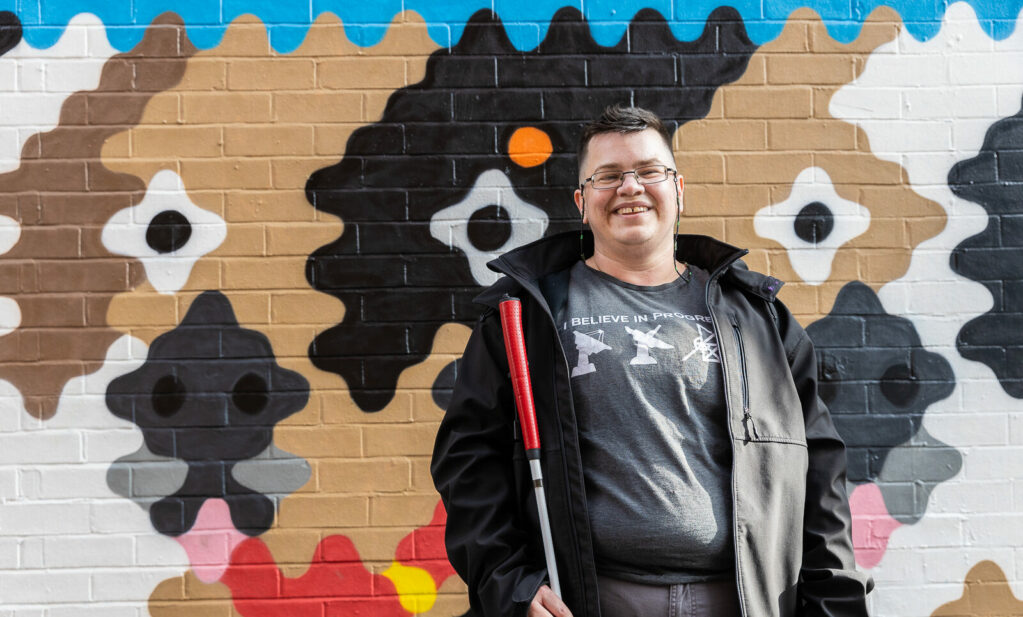Three things I learned from our Crossrail campaign success
Lianna Etkind
Previous Campaigns Manager at Transport for all (2014)
Welcome to The Platform, the blog from Transport for All putting a spotlight on disabled campaigners in the world of transport and accessibility. On The Platform you will find stories written by our members about their campaigns, and their lived experiences of using transport and streets as a disabled person.
Today’s post comes from Lianna. Lianna was Campaigns Manager at Transport for All in 2014, and a leading figure in our campaign to make Crossrail step-free. Thanks to this campaign, the Elizabeth Line in London is significantly more accessible than it would have been in the original plans…
Learning from the Crossrail Access campaign
Crossrail was a brand-new rail line spanning London and was set to cost £15bn – yet planned without step-free access!
At Transport for All, we were appalled that this project had been approved, despite the plans including seven stations that would be out of bounds to anyone that couldn’t do stairs. Over two years, our members campaigned vigorously for the Department of Transport and Transport for London (TfL), joint sponsors of Crossrail, to ensure that the line would be step-free from the day it opened. On 18th November 2014, we were thrilled to hear Baroness Kramer, the Minister for Transport, announce that funding had been found to ensure that every Crossrail station would be step-free from street to platform from the day it opened. A huge victory for disabled and older people!
Here are some of the lessons we learnt over the course of the campaign…
1. Action keeps a campaign going
Over the course of the campaign, we had regular actions: demonstrations at stations in each of the London boroughs where an inaccessible Crossrail station had been planned (Newham, Redbridge and Ealing). We brought Crossrail access biscuits to the Department of Transport, we demonstrated outside City Hall in advance of a London Assembly Transport Committee meeting, and we held a spectacular ‘Paralympic Legacy Torch Relay’ along the route of the Crossrail line, finishing at Crossrail’s Canary Wharf offices where we presented our demands. Coming together to wave placards and chant and even sing together generated a sense of energy, momentum and togetherness that kept us going. We offered activists online actions as well – many wrote to their MPs from our website, and we had lots of fun with the hashtag #CrossrailAccess. Action is not only what made the campaign, but what built friendships, community and solidarity among our members.
2. Never underestimate the power of local groups
Local groups were the backbone of the campaign. Every action was made possible by the knowledge and relationships of local Transport Action Groups which had been meeting regularly for around two years prior to the campaign; as well as three incredible, energetic residents’ associations: the Hanwell Community Forum; Seven Kings and Newbury Park Residents Association; and Manor Park Community Forum. The unglamorous work of local group meetings in community halls was the foundation on which the Crossrail campaign was built.
3. Celebrate your wins!
In early October, TfL had planned ‘Access All Areas’, a major event about transport access. Transport for All members were planning a flash mob demonstration outside calling for an accessible Crossrail. I will never forget getting a press release at 5pm the day before announcing that every London Crossrail station would be step-free, and rapidly having to convert the ‘Crossrail ain’t public transport til we can use it’ placards into ‘Thank you TfL!’ placards!
A group of our older and disabled members gathered at the appointed time, popped opened some bubbly, and together we cheered and toasted our victory! Our protest had become a celebration. Campaigning can be hard work, sometimes dispiriting, and so when campaigning is successful, it deserves recognition and celebration.
If you wanna get involved in more campaigning, support and co-produce with other disabled and older people – join us!
At Transport for All, our members are the heart of what we do. We aim to empower members to speak directly to those with power, and have a meaningful say in how transport services are run. We believe that co-production and involving people who have lived-experienced in planning, monitoring and all stages of the processes from right at the start to the end is the best way to develop and maintain a good transport network for all.
Please get in touch to find out more and get involved.

